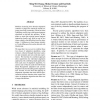Free Online Productivity Tools
i2Speak
i2Symbol
i2OCR
iTex2Img
iWeb2Print
iWeb2Shot
i2Type
iPdf2Split
iPdf2Merge
i2Bopomofo
i2Arabic
i2Style
i2Image
i2PDF
iLatex2Rtf
Sci2ools
EMNLP
2010
2010
The Necessity of Combining Adaptation Methods
Problems stemming from domain adaptation continue to plague the statistical natural language processing community. There has been continuing work trying to find general purpose algorithms to alleviate this problem. In this paper we argue that existing general purpose approaches usually only focus on one of two issues related to the difficulties faced by adaptation: 1) difference in base feature statistics or 2) task differences that can be detected with labeled data. We argue that it is necessary to combine these two classes of adaptation algorithms, using evidence collected through theoretical analysis and simulated and real-world data experiments. We find that the combined approach often outperforms the individual adaptation approaches. By combining simple approaches from each class of adaptation algorithm, we achieve state-of-the-art results for both Named Entity Recognition adaptation task and the Preposition Sense Disambiguation adaptation task. Second, we also show that applying...
Adaptation Algorithm | Adaptation Task | EMNLP 2010 | General Purpose | Natural Language Processing |
| Added | 11 Feb 2011 |
| Updated | 11 Feb 2011 |
| Type | Journal |
| Year | 2010 |
| Where | EMNLP |
| Authors | Ming-Wei Chang, Michael Connor, Dan Roth |
Comments (0)

